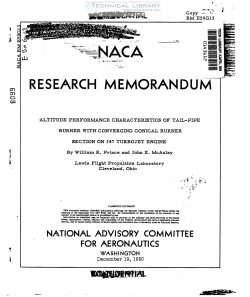naca-rm-e50g13
- Version
- 55 Downloads
- 1.24 MB File Size
- 1 File Count
- April 21, 2017 Create Date
- April 21, 2017 Last Updated
National Advisory Committee for Aeronautics, Research Memorandum - Altitude Performance Characteristics of Tail-Pipe Burner with Converging Conical Burner Section on J47 Turbojet Engine

An investigation of turhojet-engine thrust augmentation by
means of tail-pipe burning was conducted 'in the RAGA Lewis alti-
tude wind tunnel. Performance data were obtained with a tail-pipe
burner having a converging conical burner section installed on an ‘
axial-flcw-compressor type turbojet engine over a range of simu-
lated flight conditions and tail-pipe fuel-air ratios with a fixed-
area exhaust nozzle.
A maximm tail-pipe combustion efficiency of 0.86 was obtained
at an altitude of 15,000 feet and a flight Mach number of O. 25. At
an altitude of 25,000 feet, a tail-pipe burner-inlet temperature of
17000 R, and rated engine speed, the ratio of augmented thrust to
normal thrust increased from “1.5 at a flight Mach number of 0. 25 to
1.4 at a flight Mach number of 0.76. Tail-pipe burner operation was
possible up to an altitude of 45,000 feet at a flight Mach number of
0. 25.
An extensive research program on thrust augmentation of tur-
bojet engines has been conducted in the NAGA Lewis altitude wind
tunnel to determine the effect of various component designs on the
performance and operational characteristics of several tail-pipe
burner installations. The effect of flame-holder and fuel-system
design on the burner performance and the effect of altitude and
flight Mach number on over-all performance with a fixed-area exhaust
nozzle are reported in references 1 to 4. Altitude performance
characteristics of a tail-pipe burner having a converging conical
burner section are presented in this report.
Performance data were obtained with the converging-burner con-
figuration installed on a J47 turbojet engine over a range of simu-
lated flight conditions and tail-pipe fuel-air ratios with a fixed—
area exhaust nozzle. The tail-pipe burner was designed for use in
a particular airplane. The fuselage dimensions limited the maximum
diameter of the burner and necessitated the use of a converging com-
bustion chamber. The burner configuration discussed in this report
is a modified version of a tail-pipe burner whose performance is
reported in reference 2. This modification resulted from the
greater air flow of the J47 turbojet engine used in this investiga»
tion as compared with the J55 engine (reference 2). Because of the
increased air flow, it was necessary to fabricate a larger burner
to reduce the burner-inlet velocity and burner total-pressure loss.
The modified burner had the largest diameter that could be used
without making major changes in the airplane fuselage. This final
configuration incorporated the best flame holder and fuel system
previously determined from the investigation reported in reference 2.
| File | Action |
|---|---|
| naca-rm-e50g13 Altitude Performance Characteristics of Tail-Pipe Burner with Converging Conical Burner Section on.pdf | Download |

Comment On This Post